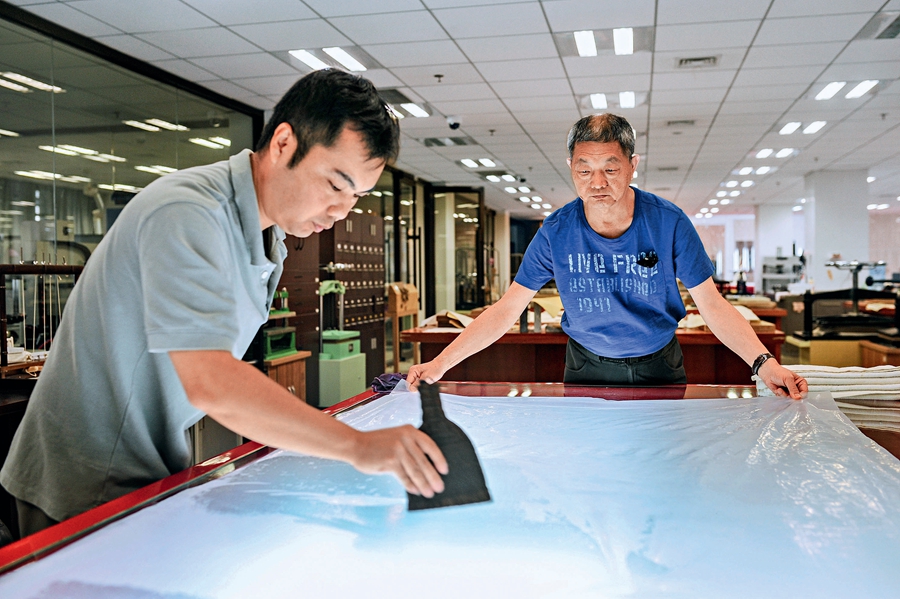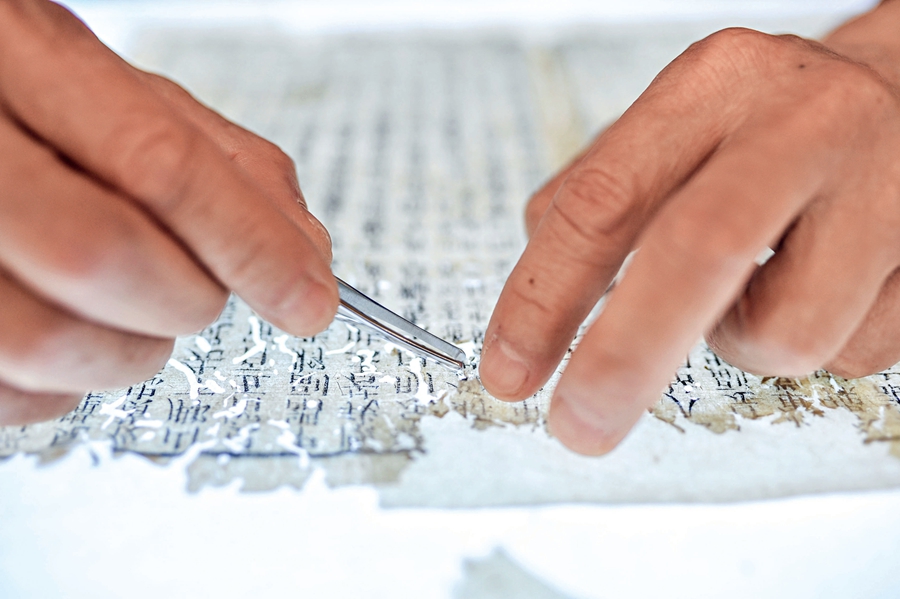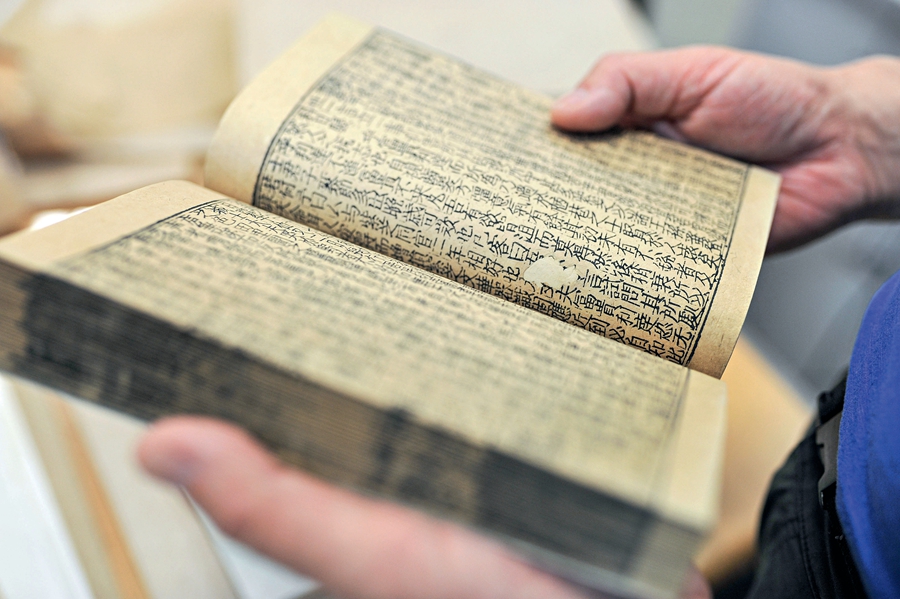By staff reporter HU YUE
DU Weisheng, who is in charge of the National Library of China’s Ancient Books Restoration Group, is 65 years old, but still vigorous. With 40 years of experience, Du feels a bit like a doctor of ancient works, and his job is to treat their illnesses. Du plays a very important role since he is an inheritor of the national intangible cultural heritage in the restoration of ancient books. He participated in the restoration of the Dunhuang Manuscripts that had been particularly damaged, the Yongle Encyclopedia which was compiled by order of the Emperor Yongle of the Ming Dynasty (1368-1644), and historical documents of the Xixia regime (1038-1227).
“The ancients gave names to different parts of the books such as the mouth, the head and the root; most correspond to organs of the human body. They treated books as if they are living creatures.” For Du, the restoration of ancient books is of great importance because it allows the people to inherit the legacy of Chinese civilization.
From Novice to Expert
Before starting work in book restoration, Du was an army engineer for five years in Hunan Province; this experience ingrained in him military discipline. Upon his retirement from the army in 1974, he was assigned to the National Library of China to join the Ancient Books Restoration Group. As a green hand, he thought the work “in the office” easier, and it gave him the opportunity to read more.
Du Weisheng is using tweezers to restore a fragmented page.
But after a few days, he realized that restoring books was not an easy job. Being a novice, he began by learning the techniques from several experienced workers, who all had a lot of talent for book restoration and edition identification. Du still remembers being left-handed, his uncompromising teacher asked him to write with the other hand. After two years of study and practice, Du, who already had some experience, was confronted with his first assignment: a paper casket unearthed in Xinjiang in 1976. As the papers on the coffin were pages of ledgers from a Tang Dynasty (618-907) post office, Du and his colleagues had to take off the sheets and assemble the pages and link them together.
Time has passed quickly, and for 40 years, Du has continued his work. Today, he is an expert in this field in China. Since the early 2000s, he has participated in the development of standards for the restoration of old books. He is currently revising the standards for the profession.
Now that he has retired, he is no longer doing restoration work, but concentrating more on teaching. “Since taking over the Ancient Books Restoration Group, I have been reforming the teaching pattern. Earlier, every young person had a designated teacher. Now, new ones can learn from all teachers. According to Du, a novice needs six months to learn the core knowledge, but it takes more than five years to master the techniques.
Training Talents and Improving Techniques
Now his group comprises around 20, most of them young people. “There are four people over 50-year-old, including myself, 13 young people under 35, and we also have eight young graduates,” he explained. Two of them have a bachelor’s degree, and the rest have a master’s degree or above, in disciplines such as chemistry, physics, and the preservation of old books. According to Du, the group’s structure is more balanced than before. “The restoration of ancient books is in fact an interdisciplinary science, one must have a good knowledge of not only classical Chinese culture, but also basic sciences such as chemistry and physics,” said Du.
A well restored book.
The change with the times also influences restoration of ancient books. Thanks to scientific knowledge, young people are improving on the traditional techniques of their teachers. He said: “When I started in this business 40 years ago, we respected experience. For example, we measured the thickness of the paper by touching. But now, an instrument can easily measure the thickness and with great precision. “
During the interview, Du analyzes a piece of paper under a microscope. Through the enlarged image of the fiber, he immediately judged the state and structure of the paper. Without the microscope, it is a lot more complicated work.
Science and technology play increasingly important roles in the restoration of ancient books. Some books, damaged and acidic, are like cancer patients according to the “doctor” of old books. With traditional techniques, it only extends their life. But today, thanks to research in chemistry and material sciences, “doctors” may be able to find solutions to defeat this particular type of cancer.
Solitary Guards
Even though new technology now plays an important role, the restoration of old books still remains primarily a manual profession that relies on the intelligence and skills of the workers. Du presented the three stages of restoration. First is the preparation stage, which includes checking the books’ information, analyzing what ails they have, developing a restoration plan, and after the verification of the experts group, they can then begin the restoration step. The second step is more complicated and delicate. They must remove the binding, get rid of the dust with tools such as brush and blade, sometimes clean the page using a suitable liquid, and sometimes deacidify the page. Then they have to restore the pages on a case-by-case basis: It is a long process that starts with tools such as brushes, scissors, tweezers and liquid glue. It is during this stage that one can truly appreciate the skills needed for restoration. The last step is binding: folding, cutting, flattening, perforating, wrapping, sewing and labeling.

Du Weisheng (right) is working with Hu Po, current head of the restoration group. With a chemistry major background, Hu is adept in ancient book restoration.
Du has performed this procedure for over four decades. He dedicated his life to the cause of ancient book restoration. His wife works in the same group as him. They support each other in their work.
When asked what the most impressive experience of his career was, Du answered without hesitation: “The restoration of the Dunhuang Manuscripts. Since 1991, we have restored 16,000 books. We have just finished this work, and we have kept 1,000 unrestored books for future generations to know about the original state of these books.
Du feels pride when he talks about his work on restoring books. But when he is in the office, he remains very humble with his colleagues – everyone focuses on their work. In fact, it is a lonely job. But people like Du are willing to stick with the job as they believe their efforts allow the future generations to inherit the traditional Chinese culture and history that has lasted for thousands of years.


